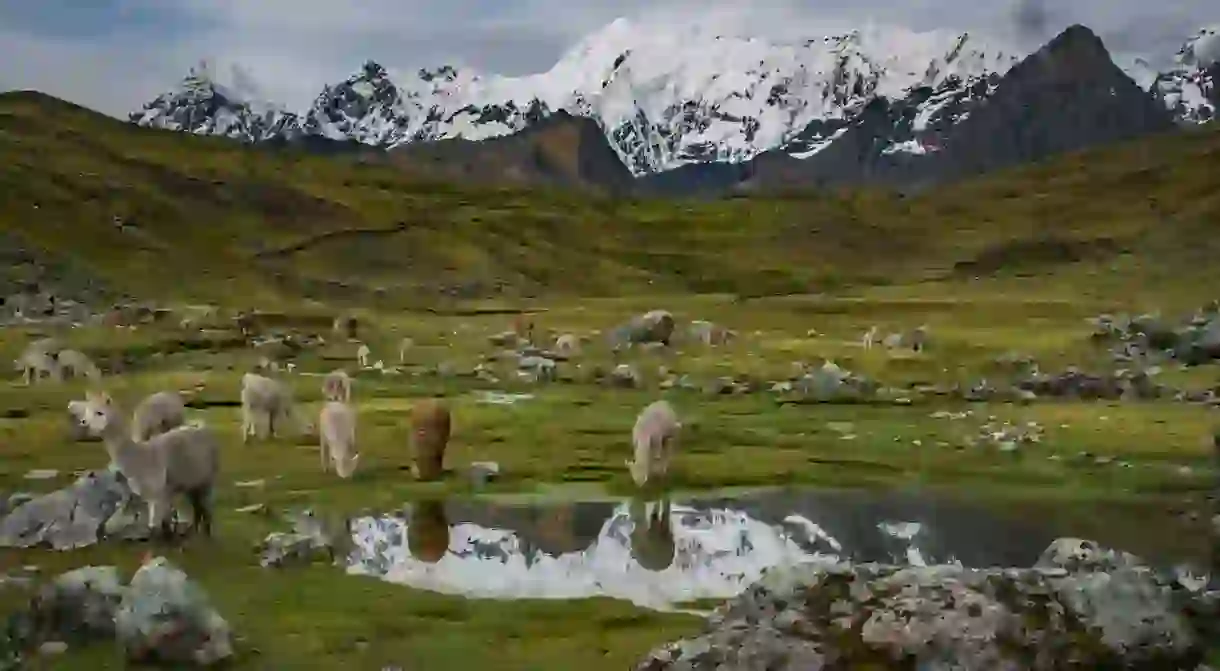17 Photos That Will Make You Want to Trek Peru's Ausangate Mountains

Just a 3-hour drive from Cusco lies one of Peru’s most stunning mountain ranges: la Cordillera de Vilcanota, more commonly known as Ausangate, after its highest peak. It’s home to one of the few remaining traditional pastoral societies in the world, meaning a trek here comes with the rare opportunity to interact with real, ancient Andean traditions. So, forget the Inca Trail, here’s why rarely visited Ausangate is worthy of your Peru itinerary.
The scenery
Whichever route you choose to take in Ausangate, you won’t be short of an epic view. Trails here are backed by dramatic, volcanic snow-capped peaks, bright green mossy earth, and fluorescent blue and yellow-tinged lakes.

These glacier lakes can be seen on most multi-day treks in Ausangate. They get their bright turquoise colour from the rich minerals that have developed on the banks and bed of the lake over thousands of years. Contrasted with the stunning reddish-brown and green mountains that surround them, they’re truly a beautiful sight to see.

The beauty of Ausangate is its diversity. One day you could be walking past towering snow peaks and blue lakes, and the next you’re clambering up rolling fields of bright red, turquoise and yellows. Cordillera de Vilcanota is home to the famous multi-coloured Rainbow Mountain, as well as many other colourful mountains, such as the Valle Rojo (Red Valley).

Often missed with the excitement of Rainbow Mountain, Valle Rojo can be accessed easily from Rainbow Mountain by dipping down into the next valley and continuing along the marked trail for another twenty minutes (the path can be seen in the image above). At 5, 200m, it’s a little bit of extra effort; but for those willing to go that extra mile, the rewards a great: a crowd-free, sea of bright reds and epic mountain vistas await.

Oh, and did we mention you’ll probably see a few llamas and alpacas along the way?

Okay, you’ll see A LOT of llamas and alpacas.

The adventure
Being home to Peru’s second highest peak, as well as hundreds of challenging trekking routes, it’s no secret that Ausangate provides boundless of adventure opportunities.

Not many people know this (yet), but Ausangate isn’t just for your average trekking – it’s a mountaineer’s paradise. From moderate acclimatisation treks to advanced technical ice climbing, these mountains have it all. And the best bit? Mountaineering here is still relatively undiscovered by tour groups (the large majority of visitors only come to visit Rainbow Mountain), so chances are you’ll have those summits all to yourself.

For those up for an adventure, wilderness camping experiences like this – with not another tent in sight – await.

The culture
Having lived pretty much undisturbed by the outside world for hundreds of years, ancient cultures and traditions in the Ausangate region are considered to be the living and breathing organism of the community – and are still practised today as they were in pre-Inca times.

The majority of people who call these mountains home – just like the many generations who came before them – are llama and alpaca farmers, earning their living from their wool and sustaining themselves entirely off Pachamama (Mother Earth). The trails we use as trekkers in the Ausangate region weren’t created for us; they’re the paths Andean farmers have been using here as trading routes for hundreds of years.

As farmers who rely on Mother Earth for their survival, the people of Ausangate consider Pachamama to be their one and only goddess. To give thanks to her, local shamans here regularly perform Pachamama rituals, where offerings such as coca leaves, brown sugar and Amazonian flowers are made to her in the hope that she’ll grant them good fortune. It’s not uncommon in Ausangate for trekkers to receive a blessing from shamans to ensure their safe ascent on Ausangate and other mountains in the area.

Another centuries-old tradition that is still practised here is the Pachamanca: a meal cooked under hot stones. Usually reserved for special occasions, what is cooked in the hot stone oven can vary. However, as they have them in abundance here, the usual ingredients are alpaca meat (marinaded in chilli, garlic, oil, salt and lime juice beforehand) and a mixture of different Andean potatoes. If you make a stop through the small village of Pacchanta, the locals here are more than happy to cook you one; it makes for the perfect post-hike feast!

The people
It goes without saying, the people here – with their traditional wear, beautiful smiles, incredible hospitality, and infectious passion for the great outdoors – are what really make these mountains special.

You won’t trek through Ausangate without meeting a beautiful soul. Always laughing, always bouncing with (way too much) energy, and always happy to tell you about their fascinating traditions, interacting with the people of Vilcanota is an experience you won’t forget in a hurry.

The women are insanely good weavers, who are always happy to show you their craft. The small amount they sell to passersby helps them buy essentials, such as salt and bars of soap, from their closest weekly market in Tinki, which is a 30-minute drive away.

Justino started selling snacks and refreshments at the base of Rainbow Mountain when it started getting popular just over two years ago. At sunrise, it’s below zero here, yet he wears open sandals and cut off linen trousers; he says he doesn’t feel the cold anymore.














